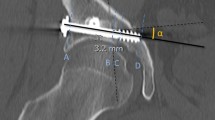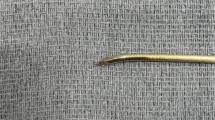Abstract
Purpose
Percutaneous screw fixation is an effective technique in addressing minimally displaced anterior column acetabular fractures. The aim of this study is to evaluate the ease of percutaneous screw insertion for acetabular anterior column fracture, as it pertains to anterograde versus retrograde insertion techniques.
Method
From 2009 to 2013, CT imaging from 30 adult volunteers (15 males, 15 females) without history of pelvic disruption and/or morphologic abnormalities were evaluated. From these images, virtual 3D pelvic models were generated. The differences area of screw starting points, limitation position of anterior column screws, and range of screw directions were analyzed.
Conclusion
We found in our analysis that anterograde and retrograde had not only variations in their starting points, but differences in areas of insertion. Typically, anterograde portals have a larger area for insertion. Additionally, given the limitations we noted in screw position and the severity of the acetabular fractures, this will allow the treating surgeon to determine the most optimal technique for percutaneous anterior column screw fixation.
Results
In our analysis, we found two areas for effective percutaneous anterograde insertion and one area for effective retrograde insertion. They both possess geometries with different shapes. Additionally, the area of anterograde insertion is larger than the retrograde area of insertion. The limitations in screw positions were shown in the AP, inlet, outlet, iliac oblique, obturator oblique, and lateral views. The direction range between superior and inferior and between medial and lateral were measured and recorded. In area of anterograde, the angle between the superior and inferior limits was \(29.2^{\circ }\pm 2.7^{\circ }\), while the angle limit between medial and lateral was \(18.5^{\circ }\pm 1.8^{\circ }\). In area of retrograde, the angle between the superior and inferior limits was \(8.32^{\circ }\pm 1.3^{\circ }\), while the angle limit between medial and lateral was \(7.5^{\circ }\pm 0.8^{\circ }\)




Similar content being viewed by others
References
Carroll EA, Huber FG, Goldman AT, Virkus WW, Pagenkopf E, Lorich DG, Helfet DL (2010) Treatment of acetabular fractures in an older population. J Orthop Trauma 24(10):637–644
Ferguson TA, Patel R, Bhandari M, Matta JM (2010) Fractures of the acetabulum in patients aged 60 years and older: an epidemiological and radiological study. J Bone Joint Surg Br 92(2):250–257
Mears DC (1999) Surgical treatment of acetabular fractures in elderly patients with osteoporotic bone. J Am Acad Orthop Surg 7(2):128–141
Vallier HA, Cureton BA, Ekstein C, Oldenburg FP, Wilber JH (2010) Early definitive stabilization of unstable pelvis and acetabulum fractures reduces morbidity. J Trauma 69(3):677–684
Bates P, Gary J, Singh G, Reinert C, Starr A (2011) Percutaneous treatment of pelvic and acetabular fractures in obese patients. Orthop Clin North Am 42(1):55–67
Starr AJ, Jones AL, Reinert CM, Borer DS (2001) Preliminary results and complications following limited open reduction and percutaneous screw fixation of displaced fractures of the acetabulum. Injury 32(Suppl 1):SA45–SA50
Starr AJ, Reinert CM, Jones AL (1998) Percutaneous fixation of the columns of the acetabulum: a new technique. J Orthop Trauma 12(1):51–58
Gay SB, Sistrom C, Wang GJ, Kahler DA, Boman T, McHugh N, Goitz HT (1992) Percutaneous screw fixation of acetabular fractures with CT guidance: preliminary results of a new technique. AJR Am J Roentgenol 158:819–822
Mouhsine E, Garofalo R, Borens O, Wettstein M, Blanc CH, Fischer JF, Moretti B, Leyvraz PF (2005) Percutaneous retrograde screwing for stabilization of acetabular fractures. Injury 36(11):1330–1336
Starr AJ, Jones AL, Reinert CM, Borer DS (2001) Preliminary results and complications following limited open reduction and percutaneous screw fixation of displaced fractures of the acetabulum. Injury 32:SA45–SA50
Giannoudis PV, Tzioupis CC, Pape HC, Roberts CS (2007) Percutaneous fixation of the pelvic ring. J Bone Joint Surg Br 89-B:145–154
Ochs BG, Marintschev I, Hoyeretal H (2010) Changes in the treatment of acetabular fractures over 15 years: analysis of 1266 cases treated by the German Pelvic Multicentre Study Group (DAO/DGU). Injury 8:839–851
Chen H, Tang P, Yao Y, She F, Wang Y (2014) Anatomical study of anterior column screw tunnels through virtual three-dimensional models of the pelvis. Eur J Orthop Surg Traumatol 25(1):105–110
Puchwein P, Enninghorst N, Sisak K, Ortner T, Schildhauer TA, Balogh ZJ, Pichler W (2012) Percutaneous fixation of acetabular fractures: computer-assisted determination of safe zones, angles and lengths for screw insertion. Arch Orthop Trauma Surg 132(6):805–811
Chen KN, Wang G, Cao LG, Zhang MC (2009) Differences of percutaneous retrograde screw fixation of anterior column acetabular fractures between male and female: a study of 164 virtual three-dimensional models. Injury 40(10):1067–1072
Starr AJ, Nakatani T, Reinert CM, Cederberg K (2008) Superior pubic ramus fractures fixed with percutaneous screws: what predicts fixation failure? J Orthop Trauma 22(2):81–87
Matta JM, Mehne DK, Roffi R (1986) Fractures of the acetabulum. Early results of a prospective study. Clin Orthop Relat Res 205:241–250
Matta JM, Merritt PO (1988) Displaced acetabular fractures. Clin Orthop Relat Res 230:83–97
Author information
Authors and Affiliations
Corresponding author
Ethics declarations
Conflict of interest
The authors declare that they have no conflict of interest.
Ethical approval
This article does not contain any studies with human participants performed by any of the authors.
Informed consent
Informed consent was obtained from all individual participants included in the study.
Additional information
Ye Peng and Lihai Zhang contributed equally to this work.
Rights and permissions
About this article
Cite this article
Peng, Y., Zhang, L., Min, W. et al. Comparison of anterograde versus retrograde percutaneous screw fixation of anterior column acetabular fractures. Int J CARS 11, 635–639 (2016). https://doi.org/10.1007/s11548-015-1308-9
Received:
Accepted:
Published:
Issue Date:
DOI: https://doi.org/10.1007/s11548-015-1308-9




